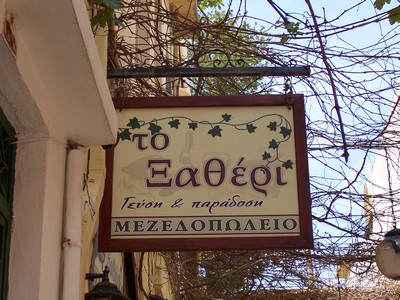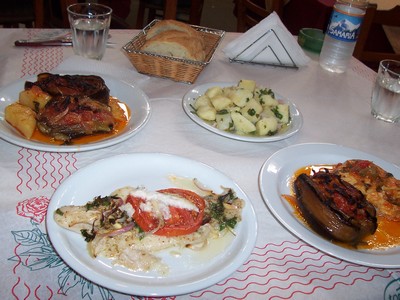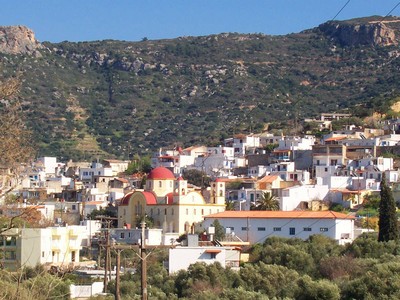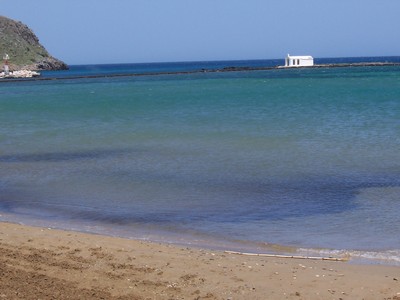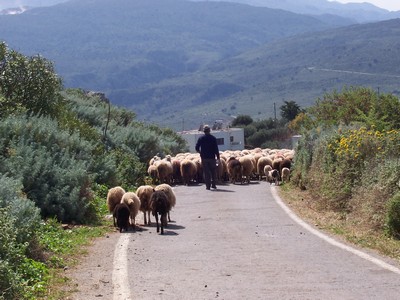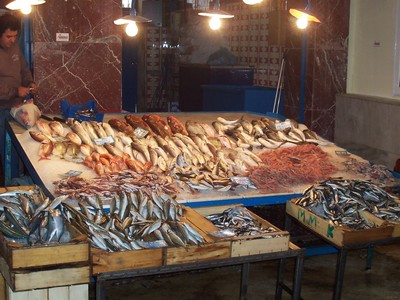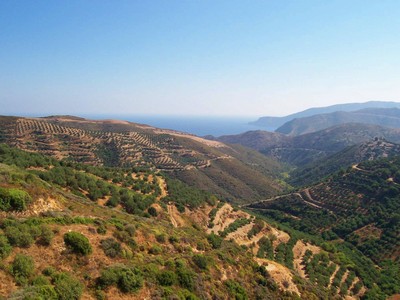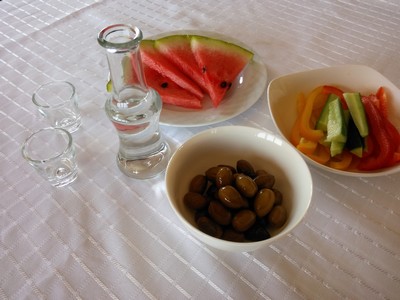Crazy about the Greek island of Crete!
Vegetarian Food in Crete
Table of Contents
Our Introduction to Vegetarian Food in Crete
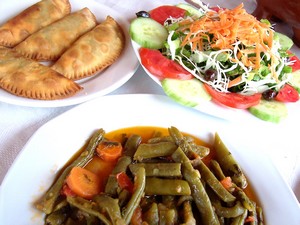
Here we hope to share our experiences of vegetarian food in Crete.
The Greeks are renowned for their grilled meat dishes, often cooked outdoors on large open BBQs.
However, there are many and varied Cretan and Greek dishes for vegetarians, especially on the Greek island of Crete, so vegetarians visiting Crete should not be apprehensive about eating out at restaurants.
Many restaurants and traditional Greek tavernas, particularly in the popular beach resorts of Crete have very similar menus with vegetarian sections listed upon them. Most menus have pictures to depict the available dish, making it very easy to choose food for vegetarians in Crete.
Away from the beach resorts of Crete and particularly in the more remote villages you’ll find great examples of healthy, tasty and cheap Cretan and Greek food for vegetarians offered in the tavernas. However, they are unlikely to have the vegetarian dishes listed separately on a menu – if they have a printed menu at all. Some places invite you into their kitchens to see what they have cooking that day rather than provide a menu.
The vegetarian food in Crete is particularly tasty as locally grown, organic and very fresh fruits and vegetables are used. More often than not the fresh vegetables and salads used in lots of family run traditional tavernas on Crete are picked fresh the same day from their own plots of land and used at lunch or dinner times to feed guests. Nothing on earth quite tastes as good as the potatoes, cucumbers, courgettes, aubergines, onions and tomatoes grown on Crete!
And of course the best olive oil in the world is produced on Crete and is liberally used in cooking and for dressing salads.
Here’s what to expect from the available Cretan and Greek food for vegetarians in Crete restaurants.
Boureki
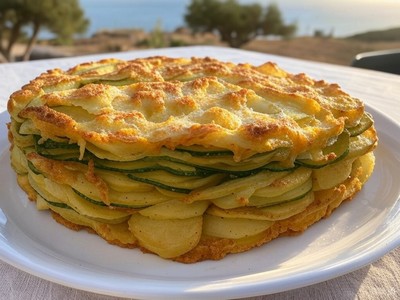
Boureki is one of those delightful Cretan dishes that perfectly captures the essence of the island’s simple, wholesome cuisine. A comforting vegetarian main course, Boureki layers thinly sliced courgettes, tender potatoes, and sweet onions, all brought together with creamy, tangy Cretan cheese—often mizithra or feta. For people who can't eat cheese, this can be left out.
Some versions feature a delicate pastry crust, adding a satisfying crunch to contrast with the soft, flavorful vegetables inside.
What makes Boureki truly special is its rustic charm; it’s a dish that feels like it’s been passed down through generations, made with love and whatever the garden has to offer. Baked until golden and bubbling, it’s hearty yet fresh, and embodies the traditional Mediterranean diet—perfect for a leisurely lunch in a village taverna or enjoyed warm from the oven at home.
Briam
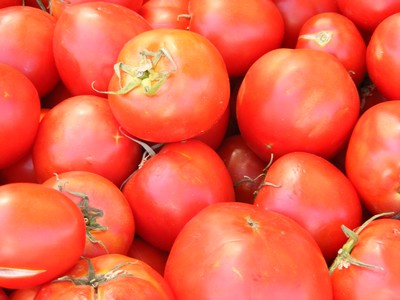
Briam is a rustic, hearty dish that captures the very essence of Cretan simplicity and Mediterranean flavors. Imagine a vibrant medley of seasonal vegetables—courgettes, aubergines, potatoes, bell peppers, and bright red ripe tomatoes—roasted together with generous glugs of Cretan extra virgin olive oil, fresh herbs like oregano and thyme, and just the right hint of garlic. The beauty of Briam lies in its laid-back, no-fuss preparation, where the vegetables roast slowly, caramelizing at the edges while soaking up all those rich, earthy flavors.
Traditionally enjoyed warm or at room temperature, Briam is often accompanied by a slab of crusty bread to mop up the delicious juices and you can sprinkle of tangy feta for a creamy contrast if you can eat cheese. It’s the kind of dish you’d find in a Cretan yiayia’s kitchen, served with love and a reminder that sometimes, the simplest ingredients create the most memorable meals.
Fava
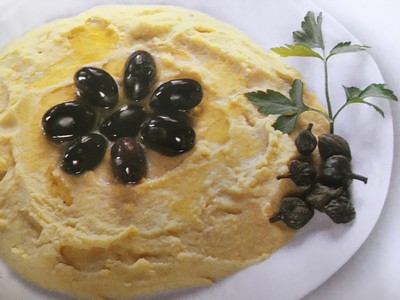
Fava is one of Crete’s most beloved traditional dishes, and despite its name, it’s not made from fava beans! Instead, it’s a silky, creamy purée crafted from yellow split peas, slow-cooked to perfection with olive oil, onions, and a hint of lemon.
The result is a deceptively simple yet incredibly flavorful dish, rich in earthy notes and a velvety texture that feels both comforting and indulgent. It’s often served as a meze, adorned with a drizzle of extra virgin olive oil, thinly sliced red onions, and a sprinkle of capers or fresh herbs for a pop of brightness.
Ingredients for Greek Fava
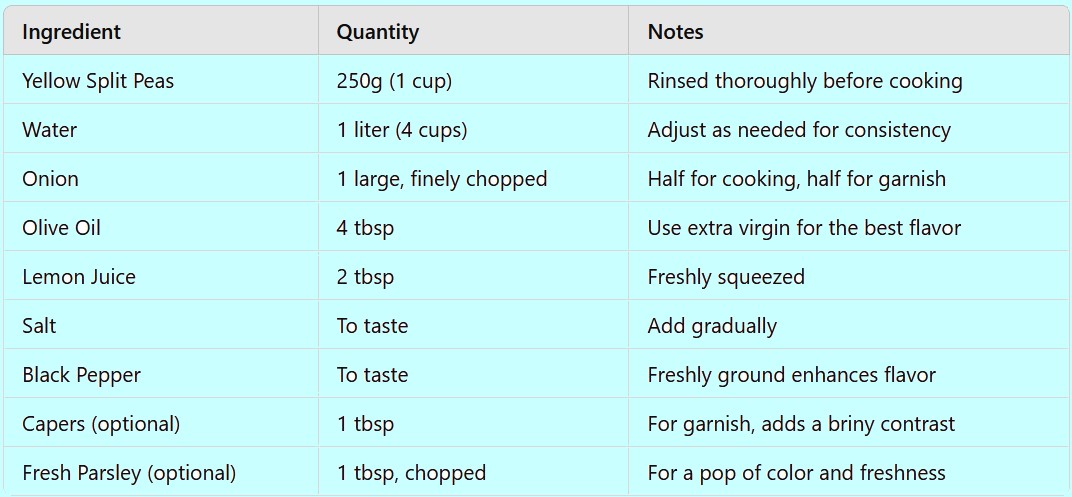
What makes Cretan fava special isn’t just its taste but its versatility. You’ll find it gracing tables in seaside tavernas, mountain villages, and bustling city eateries alike, often paired with crusty bread and a glass of chilled raki or local white wine. It’s a testament to the magic of humble ingredients elevated by traditional cooking methods—a dish that’s as nourishing as it is delicious, and a perfect example of the simplicity and depth of Cretan cuisine.
Courgette Balls
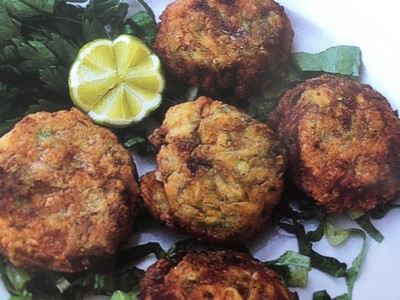
Courgette balls, or Kolokithokeftedes as they’re charmingly known in Crete, are a crispy, golden delight that showcase the island’s love affair with fresh vegetables and bold flavors. These little fritters are packed with grated courgette, crumbled feta, fresh herbs like mint and dill, and just enough flour to hold everything together before being fried to perfection. The result? A crunchy exterior that gives way to a soft, savory interior bursting with Mediterranean goodness.
Often enjoyed as part of a traditional meze spread, courgette fritters are the perfect companion to a chilled glass of raki or crisp white wine. They’re usually served with a wedge of lemon and a dollop of cool, creamy tzatziki on the side, adding a zesty kick to every bite. Whether savored in a bustling seaside taverna or whipped up at home with garden-fresh courgettes, these fritters are a taste of Crete’s simple yet irresistible culinary magic.
Fennel Pies
Fennel pies, or Marathopites as they’re lovingly called in Crete, are a delightful nod to the island’s rich culinary heritage. These savory pastries are filled with fragrant wild fennel, a staple herb in Cretan kitchens, and often mixed with other wild greens for added depth. The dough is rolled thin, encasing the fresh, aromatic filling, and then pan-fried to a crisp golden perfection. The result? A pie that’s flaky on the outside, tender and herbaceous on the inside, bursting with the anise-like notes of fennel balanced by a hint of earthy greens.
These little flavor parcels are a shining example of Vegetarian Food in Crete, where plant-based dishes aren’t just an afterthought—they’re the stars of the table. Fennel pies are usually enjoyed as part of a mezze spread or as a light snack, often paired with a drizzle of olive oil and a squeeze of fresh lemon to elevate their natural flavors. Simple, rustic, and incredibly satisfying, Marathopites capture the essence of Cretan cuisine: fresh, seasonal ingredients, handled with care, and rooted deeply in tradition.
Greek Salad
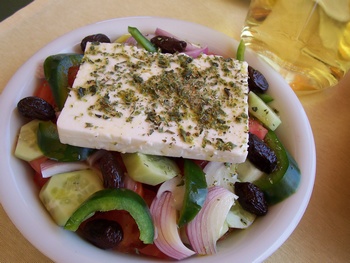
Greek Salad is one of those must try eating experiences that every visitor to Greece and Crete try.
The simple but tasty salad contains green pepper, onion, tomato, cucumber and olives topped with feta cheese sprinkled with oregano and dressed with plenty of olive oil and lemon juice. Many other salads make up the available vegetarian food in Crete.
Giant Beans
Giant beans, known locally as Gigantes Plaki, are a beloved staple in Cretan cuisine and a shining example of Vegetarian Food in Crete. These hearty, oven-baked butter beans are slow-cooked in a rich, tangy tomato sauce infused with olive oil, garlic, onions, and a medley of fresh herbs like dill and parsley. The beans absorb all those vibrant Mediterranean flavors, becoming wonderfully tender with a melt-in-the-mouth texture. A generous drizzle of extra virgin olive oil just before serving adds that signature Cretan touch, enhancing the dish’s velvety richness.
Often enjoyed as a main course or part of a traditional mezze spread, Gigantes Plaki is the kind of dish that proves simplicity can be spectacular. Served warm with crusty bread to mop up the luscious sauce—or even enjoyed cold the next day—it’s a testament to how plant-based dishes are at the heart of Cretan culinary tradition. In Crete, vegetarian fare isn’t a modern trend; it’s an age-old celebration of seasonal, wholesome ingredients, and giant beans are a delicious reminder of that heritage.
Green Beans in Tomato Sauce
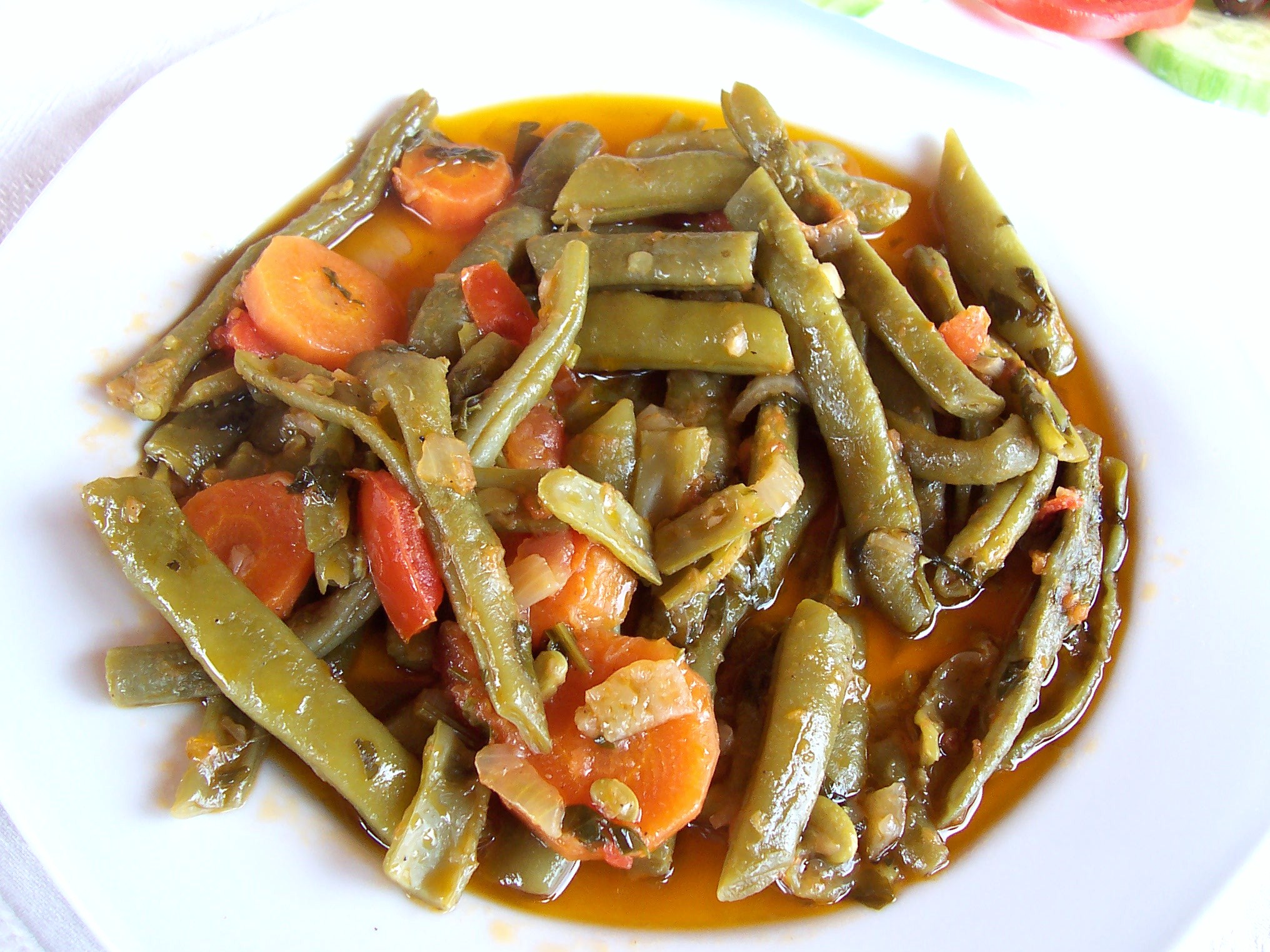
Green Beans in Tomato Sauce, known locally as Fasolakia Ladera, is a beloved staple that perfectly embodies the essence of Vegetarian Food in Crete. This humble yet hearty dish combines tender green beans, juicy tomatoes, onions, and fragrant olive oil, slowly simmered to create a rich, flavorful sauce. The beauty of Fasolakia lies in its simplicity—each ingredient shines, especially when made with sun-ripened tomatoes and Cretan extra virgin olive oil, which adds depth and a silky texture to the dish.
Often served with a side of crusty village bread to soak up the delicious sauce, Fasolakia is a true testament to how fresh, seasonal vegetables can create an unforgettable meal. It’s a common sight on Cretan family tables and in traditional tavernas, offering a satisfying, plant-based option that’s as nourishing as it is tasty. Whether enjoyed warm or at room temperature, this dish captures the spirit of Cretan cuisine—wholesome, vibrant, and deeply connected to the land.
Horta (Wild Greens)
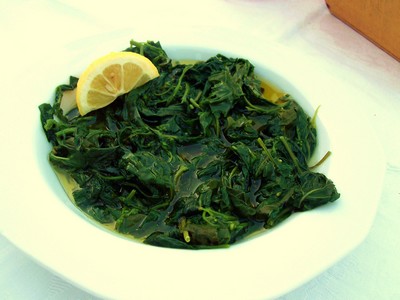
Horta, a brilliant example of vegetarian food in Crete, is a simple yet deeply nourishing dish made from wild leafy greens foraged from the island’s rugged hillsides.
Typically boiled and drizzled with a generous splash of extra virgin olive oil and a squeeze of fresh lemon, Horta showcases the earthy, slightly bitter flavors of greens like dandelion, chicory, or amaranth.
Served warm or at room temperature, it’s a staple on Cretan tables, offering a refreshing, healthy accompaniment to any meal and a true taste of the island’s rich agricultural heritage.
Stuffed Courgette Flowers
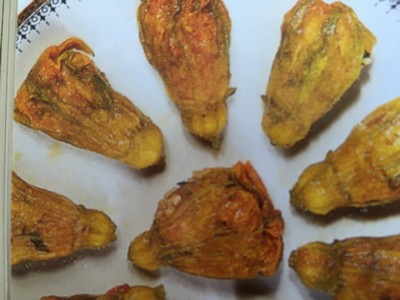
Stuffed courgette flowers (zucchini) are not on every menu in the Crete restaurants and traditional Greek tavernas. But when they are they are delicious.
Unlike the stuffed vine leaves that are sometimes tinned and not homemade, stuffed courgette flowers are always prepared fresh. The stuffing is a seasoned rice mix.
Stuffed Peppers and Stuffed Tomatoes
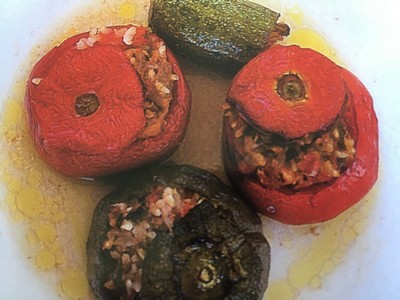
Stuffed peppers and/or stuffed tomatoes tend to be the go to choice for many vegetarians visitors to Crete. The vegetables known as Gemista are oven baked with a stuffing of seasoned rice.
However vegetarians need to be certain that they do not also contain mince meat which is sometimes the case. Check with the waiter if you are uncertain.
Stuffed Vine Leaves
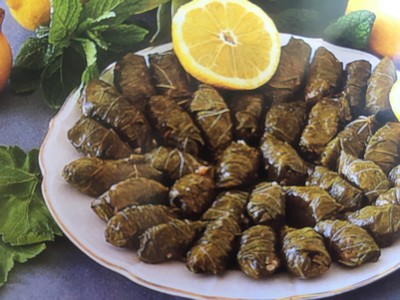
Stuffed vine leaves, or Dolmades, are a quintessential part of Cretan cuisine and a standout in the rich tapestry of Vegetarian Food in Crete. These delicate parcels are made by wrapping tender vine leaves around a fragrant mixture of rice, fresh herbs like dill and mint, finely chopped onions, and a generous splash of olive oil—Crete’s liquid gold. The filling is often brightened with a hint of lemon juice, giving each bite a zesty, refreshing tang that perfectly complements the earthy flavor of the vine leaves.
Traditionally served as part of a mezze platter or enjoyed as a light appetizer, Dolmades are a testament to how simple ingredients can create extraordinary flavors. What makes them even more special is their versatility—served warm with a dollop of cool, creamy yogurt or savored cold as a refreshing snack. In Crete, dishes like stuffed vine leaves aren’t just meals; they’re a celebration of seasonal produce, fresh herbs, and time-honored culinary traditions that showcase how vibrant and satisfying vegetarian food can truly be.
Non-Meat Dishes That Contain Cheese
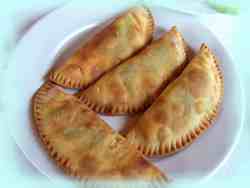
Cheese Pies
Cheese Pies are the ubiquitous vegetarian food in Crete. The Cretans have them for breakfast! There are various versions of cheese pie. Some are absolutely huge – the ones for breakfast – and some are tiny mini pasty shaped. The pastry is Filo pastry and the cheese filling is a mild white creamy cheese. Sometimes cheese pies are served with local honey.
Saganaki
Saganaki is one of those Greek dishes for vegetarians that are different in each restaurant you visit in Greece and Crete. Basically its fried cheese but variations of cheese are often offered with haloumi being the most common. It is tastier than it sounds. Prawn or shrimp Saganaki is another variation.
Dakos
Dakos is a classic vegetarian food in Crete. It is often listed as Cretan Salad on restaurant menus. Doubled baked barley rusks form the basis of this Cretan dish which is topped with grated tomato and crumble feta cheese.
We hope you have got a flavour of the Crete Vegetarian dishes showcased here. Visit Crete soon to discover the vibrant world of Vegetarian Food in Crete, featuring traditional dishes like stuffed vine leaves, giant beans, boureki, and horta, all showcasing the island's fresh, local ingredients and rich culinary heritage.
from our
Want to discover even more of what Crete has to offer?
Explore hidden gems, must-visit spots, and insider tips below!
Just Some of the Reasons We Love Crete
Did you love this page? Please share it with your friends!
© Copyright All Original Content 2006 - 2025 Completely-Crete.com. All
Rights Reserved. Reproduction in whole or in part without permission is
not permitted.
Click here to learn about developing your own money-generating website
from Solo Build It! - even with little or no web experience!
